| 中文名稱 | 心肌肌鈣蛋白I抗體 |
| 別 名 | Cardiac Troponin I; cardiac muscle; Troponin I, cardiac muscle; Cardiomyopathy, familial hypertrophic, 7, included; CMD1FF; CMD2A; CMH7; cTnI; Familial hypertrophic cardiomyopathy 7; MGC116817; RCM1; Tn1; Tni; TNN I3; TNNC 1; TNNC1; TNNI3; TNNI3; TNNI3_HUMAN; Troponin I; Troponin I cardiac; Troponin I cardiac muscle; Troponin I cardiac muscle isoform; Troponin I type 3 cardiac; troponin I, cardiac 3; TroponinI; Ttroponin I type 3 (cardiac). |
| 研究領(lǐng)域 | 心血管 發(fā)育生物學(xué) 信號(hào)轉(zhuǎn)導(dǎo) 干細(xì)胞 細(xì)胞骨架 |
| 抗體來源 | Rabbit |
| 克隆類型 | Polyclonal |
| 交叉反應(yīng) | Mouse, Rat, (predicted: Human, ) |
| 產(chǎn)品應(yīng)用 | WB=1:500-2000 ELISA=1:500-1000 IHC-P=1:100-500 IHC-F=1:100-500 ICC=1:100-500 IF=1:100-500 (石蠟切片需做抗原修復(fù)) not yet tested in other applications. optimal dilutions/concentrations should be determined by the end user. |
| 分 子 量 | 24kDa |
| 細(xì)胞定位 | 細(xì)胞漿 |
| 性 狀 | Liquid |
| 濃 度 | 1mg/ml |
| 免 疫 原 | KLH conjugated synthetic peptide derived from human TNNI3:131-210/210 |
| 亞 型 | IgG |
| 純化方法 | affinity purified by Protein A |
| 儲(chǔ) 存 液 | 0.01M TBS(pH7.4) with 1% BSA, 0.03% Proclin300 and 50% Glycerol. |
| 保存條件 | Shipped at 4℃. Store at -20 °C for one year. Avoid repeated freeze/thaw cycles. |
| PubMed | PubMed |
| 產(chǎn)品介紹 | Troponin I (TnI), along with troponin T (TnT) and troponin C (TnC), is one of 3 subunits that form the troponin complex of the thin filaments of striated muscle. TnI is the inhibitory subunit; blocking actin-myosin interactions and thereby mediating striated muscle relaxation. The TnI subfamily contains three genes: TnI-skeletal-fast-twitch, TnI-skeletal-slow-twitch, and TnI-cardiac. This gene encodes the TnI-cardiac protein and is exclusively expressed in cardiac muscle tissues. Mutations in this gene cause familial hypertrophic cardiomyopathy type 7 (CMH7) and familial restrictive cardiomyopathy (RCM). [provided by RefSeq]. Function: Troponin I is the inhibitory subunit of troponin, the thin filament regulatory complex which confers calcium-sensitivity to striated muscle actomyosin ATPase activity. Post-translational modifications: Phosphorylated at Ser-42 and Ser-44 by PRKCE; phosphorylation increases myocardium contractile dysfunction. Phosphorylated at Ser-23 and Ser-24 by PRKD1; phosphorylation reduces myofilament calcium sensitivity. Phosphorylated preferentially at Thr-31. Phosphorylation by STK4/MST1 alters its binding affinity to TNNC1 (cardiac Tn-C) and TNNT2 (cardiac Tn-T). DISEASE: Defects in TNNI3 are the cause of cardiomyopathy familial hypertrophic type 7 (CMH7) [MIM:613690]. Familial hypertrophic cardiomyopathy is a hereditary heart disorder characterized by ventricular hypertrophy, which is usually asymmetric and often involves the interventricular septum. The symptoms include dyspnea, syncope, collapse, palpitations, and chest pain. They can be readily provoked by exercise. The disorder has inter- and intrafamilial variability ranging from benign to malignant forms with high risk of cardiac failure and sudden cardiac death. Defects in TNNI3 are the cause of cardiomyopathy familial restrictive type 1 (RCM1) [MIM:115210]. RCM1 is an heart muscle disorder characterized by impaired filling of the ventricles with reduced diastolic volume, in the presence of normal or near normal wall thickness and systolic function. Defects in TNNI3 are the cause of cardiomyopathy dilated type 2A (CMD2A) [MIM:611880]. Dilated cardiomyopathy is a disorder characterized by ventricular dilation and impaired systolic function, resulting in congestive heart failure and arrhythmia. Patients are at risk of premature death. Defects in TNNI3 are the cause of cardiomyopathy dilated type 1FF (CMD1FF) [MIM:613286]. Dilated cardiomyopathy is a disorder characterized by ventricular dilation and impaired systolic function, resulting in congestive heart failure and arrhythmia. Patients are at risk of premature death. Similarity: Belongs to the troponin I family. SWISS: P19429 Gene ID: 7137 Database links: Entrez Gene: 493744 Cat Entrez Gene: 511094 Cow Entrez Gene: 403566 Dog Entrez Gene: 7137 Human Entrez Gene: 21954 Mouse Entrez Gene: 100049696 Pig Entrez Gene: 29248 Rat Omim: 191044 Human SwissProt: Q863B6 Cat SwissProt: P08057 Cow SwissProt: Q8MKD5 Dog SwissProt: P19429 Human SwissProt: P48787 Mouse SwissProt: P02646 Rabbit SwissProt: P23693 Rat Unigene: 709179 Human Unigene: 27674 Mouse Unigene: 64141 Rat Important Note: This product as supplied is intended for research use only, not for use in human, therapeutic or diagnostic applications. |
| 產(chǎn)品圖片 | 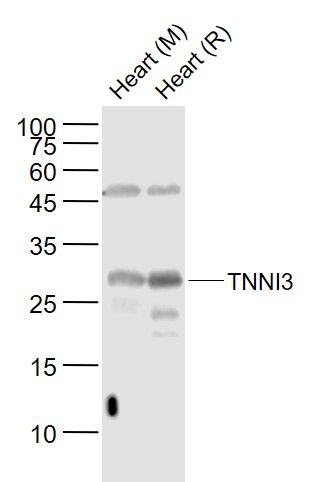 Sample: Sample:Lane 1: Heart (Mouse) Lysate at 40 ug Lane 2: Heart (Rat) Lysate at 40 ug Primary: Anti-TNNI3 (bs-10614R ) at 1/1000 dilution Secondary: IRDye800CW Goat Anti-Rabbit IgG at 1/20000 dilution Predicted band size: 28 kD Observed band size: 28 kD 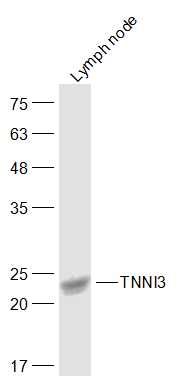 Sample: Sample:Lymph node(Rat) Cell Lysate at 40 ug Primary: Anti-TNNI3 (bs-10614R) at 1/300 dilution Secondary: IRDye800CW Goat Anti-Rabbit IgG at 1/20000 dilution Predicted band size: 24 kD Observed band size: 24 kD 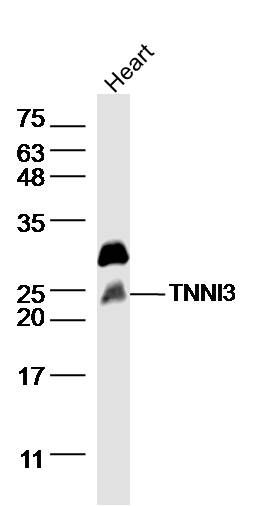 Sample: Sample:heart(rat)Lysate at 40 ug Primary: Anti- TNNI3 (bs-10614R)at 1/300 dilution Secondary: IRDye800CW Goat Anti-Rabbit IgG at 1/20000 dilution Predicted band size: 24kD Observed band size: 24 kD 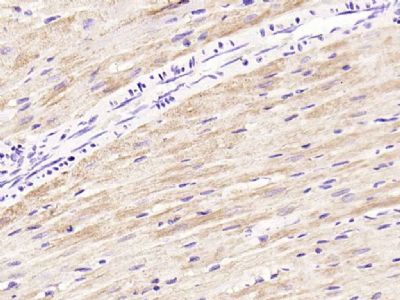 Paraformaldehyde-fixed, paraffin embedded (mouse heart); Antigen retrieval by boiling in sodium citrate buffer (pH6.0) for 15min; Block endogenous peroxidase by 3% hydrogen peroxide for 20 minutes; Blocking buffer (normal goat serum) at 37°C for 30min; Antibody incubation with (TNNI3) Polyclonal Antibody, Unconjugated (bs-10614R) at 1:200 overnight at 4°C, followed by operating according to SP Kit(Rabbit) (sp-0023) instructionsand DAB staining. Paraformaldehyde-fixed, paraffin embedded (mouse heart); Antigen retrieval by boiling in sodium citrate buffer (pH6.0) for 15min; Block endogenous peroxidase by 3% hydrogen peroxide for 20 minutes; Blocking buffer (normal goat serum) at 37°C for 30min; Antibody incubation with (TNNI3) Polyclonal Antibody, Unconjugated (bs-10614R) at 1:200 overnight at 4°C, followed by operating according to SP Kit(Rabbit) (sp-0023) instructionsand DAB staining.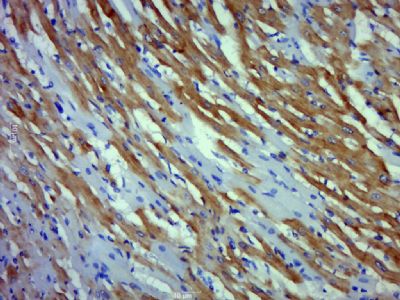 Paraformaldehyde-fixed, paraffin embedded (Rat heart); Antigen retrieval by boiling in sodium citrate buffer (pH6.0) for 15min; Block endogenous peroxidase by 3% hydrogen peroxide for 20 minutes; Blocking buffer (normal goat serum) at 37°C for 30min; Antibody incubation with (TNNI3) Polyclonal Antibody, Unconjugated (bs-10614R) at 1:500 overnight at 4°C, followed by a conjugated secondary (sp-0023) for 20 minutes and DAB staining. Paraformaldehyde-fixed, paraffin embedded (Rat heart); Antigen retrieval by boiling in sodium citrate buffer (pH6.0) for 15min; Block endogenous peroxidase by 3% hydrogen peroxide for 20 minutes; Blocking buffer (normal goat serum) at 37°C for 30min; Antibody incubation with (TNNI3) Polyclonal Antibody, Unconjugated (bs-10614R) at 1:500 overnight at 4°C, followed by a conjugated secondary (sp-0023) for 20 minutes and DAB staining. |









